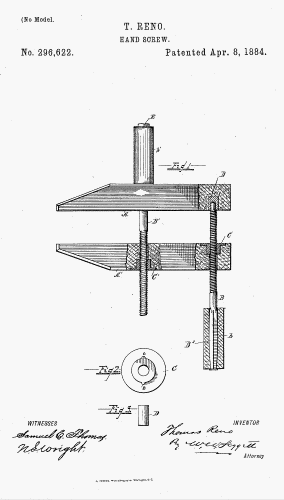
Top of Site > Company Information > Patents for Clamps > Detroit Machine Screw Works
Note that, after application but before granting of this patent, the Reno Vise Company also used this design.
| Patent Number | 296 622 |
| Date Applied For | 1884 Jan 14 |
| Date Issued | 1884 Apr 4 |
| Issued to | Thomas Reno |
| Location | Detroit MI |
| Current Class/ subclass | 269/ 219, 286 |
Quoting from the patent:
In the drawings, Figure 1 is a front elevation of a device embodying my invention, showing parts in section. Figure 2 is a separate view of one of the nuts. Figure 3 is a separate view of the thimble.
In the drawings, A and A' represent the jaws; B and B', metallic screws provided with suitable handles, b and b'. To receive the handle I prefer to square the end of the screw shaft, as shown at B2, or otherwise shape the end of said shaft so that it will not be liable to turn in the handle.
The specifications will be quoted in full, as they present the many considerations in replacing wooden screws with metal screws.
It is evident that in operation a drawing force will be exerted upon the screw B', whereby there will be more or less liability to draw the screw shaft from the handle b'. To prevent this, however, I prefer to screw-cut the end of the shaft, and to provide it with a suitable nut, as shown at E. On the other hand, on the screw B a forcing pressure is exerted, and consequently a tendency to draw the shaft of the screw from the handle b does not need to be guarded against, so that the handle may be suitable located upon the shaft of the screw in any proper manner.
It will be seen that by employing metallic screws instead of the ordinary wooden ones, much smaller screws can be used, requiring less action to obtain a tight grip, while at the same time a tighter grip may be obtained without any liability of twisting off the handle or shaft, and without the liability of stripping the threads.
By manufacturing hand-screws in this manner, furthermore, longer screws can be employed for the same length of jaw than where wooden screws are employed, thus providing for a wider opening of the jaws, with less danger of stripping the threads or of twisting off the screw - a common occurrence with the old-fashioned hand-screw. In larger sizes, too, in consequence of having finer screw-threads than is common with ordinary wooden screw, when greater power is required to obtain a severe grip, it can be obtained much more readily.
While I do not wish to limit myself to any particular kind of screw-thread, instead, however, of constructing the screws and jaws with the V-thread, I prefer to construct said parts with a ratchet-thread - i.e., with a thread having a square face, as shown - as this construction of th thread is much better.
Instead of providing the jaws with ordinary wooden screw-threads to receive the screw, I may locate in the jaws suitable metallic nuts, C and C', without departing from the principle of my invention. These nuts may be secured in the jaws in any suitable manner. A suitable socket may be provided in the jaws to receive said nuts, which may then be riveted into place; but I prefer to provide said nuts with ribs c, and to force the nuts into place by pressure, said ribs running parallel with the grain of the wood, which construction will prevent the necessity of rivets to hold the nuts in place. I do not, however, limit myself to any particular method of securing the nuts in the jaws. By providing the nuts with the ribs c they will be prevented from turning in the jaws.
D is a thimble adapted to receive the end of the screw B, the end of said screw being preferably reamed down to fit the thimble, the thimble being sufficiently deep to give the proper length, in order that the screw may work freely in the sockets of the thimble. By the employment of this thimble there is no liability of wearing upon the wood, as would otherwise be the case. The thimble might, however, be omitted without departing from the principle of my invention. Moreover, the various parts which are constructed of metal may readily be made in duplicates - i.e., the nuts C and C' are duplicates of each other. The thimble D may also be manufactured in duplicates of any desired number, and each of the screws B and B', so that each like part is interchangeable - a fact of considerable importance in the manufacture of the device, and should any repairs be necessary.
A hand-screw thus constructed is more durable, more easily operated, and provides for a firmer grip than has hitherto been th case with hand-screws of this nature as commonly manufactured.
last revised and validated
Copyright © 1996- Wooden Clamp Journal